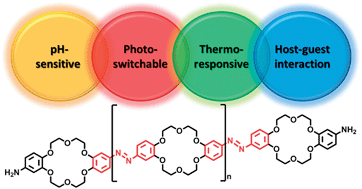Multi-stimuli responsive poly(azodibenzo-18-crown-6-ether)s†
Abstract
New main chain azopolymers comprising dibenzo-18-crown-6-ether units joined by azo-bridges have been prepared and fractionated. UV-vis studies show that the polymers are solvatochromic and pH-sensitive. Upon irradiation with specific wavelengths they undergo reversible trans-to-cis photo-isomerisation. Owing to the nature of the crown ether moiety, the polymers can furthermore interact with low molar mass pyridinium guests and Ba2+ metal ions, resulting in complex-induced phase separation in solvents of lower polarity. In alcohols, the upper critical solution temperature (UCST) type transitions are observed, which are strongly dependent on the polymer concentration and the degree of polymerization. Irradiation of the polymers leads to reversible photo-tuning of the demixing temperature, which decreases proportionally to the decrease in the trans content of the sample. The UCST-type transitions in alcohols are also influenced by the water content in the mixtures and addition of barium ions results in an increase of the demixing temperature. Irradiation of the polymer–barium complexes induces the photo-isomerisation but does not change the demixing temperature.


 Please wait while we load your content...
Please wait while we load your content...